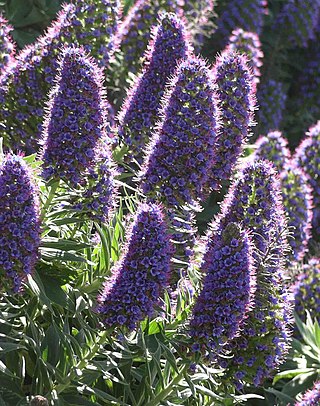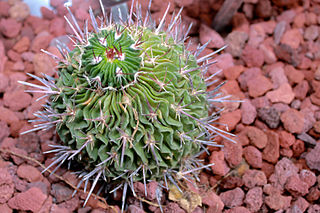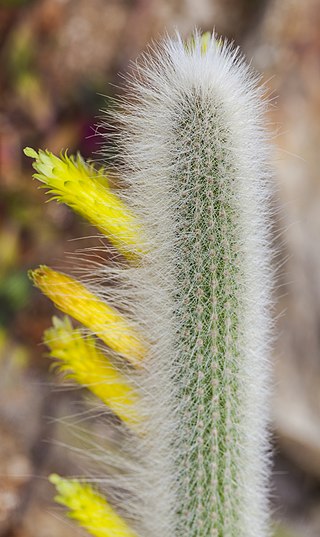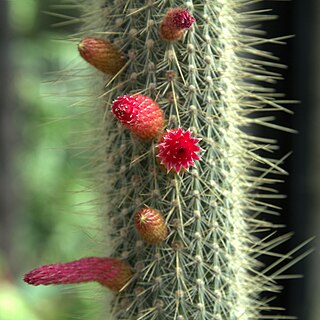
Cleistocactus is a genus of flowering plants in the cactus family Cactaceae, native to mountainous areas - to 3,000 m (9,843 ft) - of South America. The name comes from the Greek kleistos meaning closed because the flowers hardly open.

Cleistocactus strausii, the silver torch or wooly torch, is a perennial flowering plant in the family Cactaceae. It is native to mountainous regions of Department Tarija, Bolivia, at 1,500–3,000 m (4,921–9,843 ft).

Stetsonia coryne, the toothpick cactus, is the sole species in the cactus genus Stetsonia. Stetsonia coryne grows to a height of 15 to 25 ft tall. It has white flowers.

Samaipaticereus is a genus of cactus containing the sole species Samaipaticereus corroanus. It is known only from East Andean Bolivia and Peru.

Yungasocereus inquisivensis is a species of cactus native to Bolivia; it is the sole member of the genus Yungasocereus.

Cleistocactus winteri is a succulent of the family Cactaceae. Its common name is the golden rat tail. Cleistocactus winteri subsp. colademono, as its synonym Cleistocactus colademononis, has gained the Royal Horticultural Society's Award of Garden Merit.

Echium candicans, the 'Pride of Madeira', is a species of flowering plant in the family Boraginaceae, native to the island of Madeira. It is a large herbaceous perennial subshrub, growing to 1.5–2.5 m.

Cleistocactus hyalacanthus is a species of columnar cacti in the genus Cleistocactus. The name comes from the Greek kleistos meaning closed because the flowers hardly open.

Physoplexis comosa, the tufted horned rampion, is a species of flowering plant in the family Campanulaceae, native to alpine Europe. It is the only species in its genus, and was formerly included in Phyteuma.

Stenocactus multicostatus, the brain cactus, is a member of the cactus family native to the deserts of Mexico, and is popular in the gardening community. It has gained the Royal Horticultural Society's Award of Garden Merit. Though it has only been reported in the shrublands of Chihuahua, Coahuila, Durango, Nuevo León, San Luis Potosí, Zacatecas, and Tamaulipas, it has yet to be assessed using the IUCN Categories and Criteria because its taxonomy is still unclear.

Cleistocactus tominensis is a species of columnar cactus in the genus Cleistocactus, endemic to Bolivia, where it is found in forests, on cliffs, and in inter-Andean valleys at altitudes of 900 to 2,200 meters.

Lobivia ancistrophora is a species of cactus. It has a globular shape, few spines, with large, white flowers attached to long, green tubes. It occurs in Bolivia, at altitudes of 600–1800 metres. Under its synonym Echinopsis ancistrophora it has gained the Royal Horticultural Society's Award of Garden Merit.

Mirabella estevesii, synonym Cereus estevesii, is a species of columnar cactus found in Minas Gerais, Brazil. The first description was published in 2004 by Pierre Josef Braun as Cereus estevesii.

Cleistocactus ritteri is a species of Cleistocactus found in Bolivia.

Cleistocactus smaragdiflorus is a species of Cleistocactus found in Bolivia and Argentina.

Cleistocactus candelilla is a species of Cleistocactus found in Bolivia.

Cleistocactus brookeae is a species of columnar cacti in the genus Cleistocactus.

Cleistocactus buchtienii is a species of columnar cacti in the genus Cleistocactus.

Cleistocactus parviflorus is a species of columnar cacti in the genus Cleistocactus.

Oreocereus pseudofossulatus is a species of Oreocereus found in Bolivia.



























